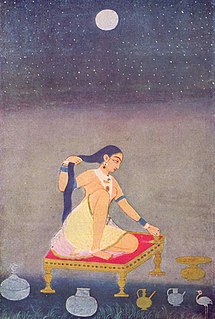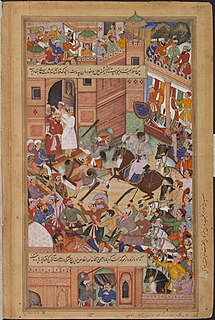Related Research Articles

Nur-ud-din Muhammad Salim, known by his imperial name Jahangir, was the fourth Mughal Emperor, who ruled from 1605 until his death in 1627. His imperial name means 'conqueror of the world', 'world-conqueror' or 'world-seizer'.

Gouache, body color, or opaque watercolor, is one type of watermedia, paint consisting of natural pigment, water, a binding agent, and sometimes additional inert material. Gouache is designed to be opaque. Gouache has a considerable history, going back at least 1200 years. It is used most consistently by commercial artists for posters, illustrations, comics, and other design work.
Webcomics are comics published on a website or mobile app. While many are published exclusively on the web, others are also published in magazines, newspapers, or comic books.

Ustad Mansur was a seventeenth-century Mughal painter and court artist. He grew up during the reign of Jahangir during which period he excelled at depicting plants and animals. He was the earliest artist to depict the dodo in colour, apart from being the first to illustrate the Siberian crane. Towards the end of Akbar's reign, he gained the title of ustad (=master) and during the reign of Mughal Emperor Jahangir his masterpieces earned him the title of Nãdir-al-’Asr. Although largely known for his natural history illustrations, he also portrayed people in various manuscript illustrations.

Mughal painting is a particular style of South Asian, particularly North Indian, painting confined to miniatures either as book illustrations or as single works to be kept in albums (muraqqa). It emerged from Persian miniature painting and developed in the court of the Mughal Empire of the 16th to 18th centuries. The Mughal emperors were Muslims and they are credited with consolidating Islam in South Asia, and spreading Muslim arts and culture as well as the faith.

Indian painting has a very long tradition and history in Indian art, though because of the climatic conditions very few early examples survive. The earliest Indian paintings were the rock paintings of prehistoric times, such as the petroglyphs found in places like Bhimbetka rock shelters. Some of the Stone Age rock paintings found among the Bhimbetka rock shelters are approximately 10,000 years old.

The Bāburnāma is the memoirs of Ẓahīr-ud-Dīn Muhammad Bābur (1483–1530), founder of the Mughal Empire and a great-great-great-grandson of Timur. It is written in the Chagatai language, known to Babur as "Turki", the spoken language of the Andijan-Timurids. During Emperor Akbar's reign, the work was completely translated to Persian, the usual literary language of the Mughal court, by a Mughal courtier, Abdul Rahīm, in AH 998 (1589–90). Translations into many other languages followed, mostly from the 19th century onwards.

The Akbarnama, which translates to Book of Akbar, the official chronicle of the reign of Akbar, the third Mughal Emperor, commissioned by Akbar himself by his court historian and biographer, Abu'l-Fazl ibn Mubarak, called one of the "nine jewels in Akbar's court" by Mughal writers. It was written in Persian, which is the literary language of the Mughals, and includes vivid and detailed descriptions of his life and times. It followed the Baburnama, the more personal memoir by his grandfather, Babur, founder of the dynasty. Like that, it was produced in the form of lavishly illustrated manuscripts.

Tutinama, literal meaning "Tales of a Parrot", is a 14th-century Persian series of 52 stories. The work remains well-known largely because of a number of lavishly illustrated manuscripts, especially a version containing 250 miniature paintings was commissioned by the Mughal Emperor, Akbar in the 1550s. The Persian text used was redacted in 14th century AD in Iran from an earlier anthology ‘Seventy Tales of the Parrot’ in Sanskrit compiled under the title Śukasaptati dated to the 12th century AD. In Iran, as in India, parrots are popular as storytellers in works of fiction.

A Muraqqa is an album in book form containing Islamic miniature paintings and specimens of Islamic calligraphy, normally from several different sources, and perhaps other matter. The album was popular among collectors in the Islamic world, and by the later 16th century became the predominant format for miniature painting in the Persian Safavid, Mughal and Ottoman empires, greatly affecting the direction taken by the painting traditions of the Persian miniature, Ottoman miniature and Mughal miniature. The album largely replaced the full-scale illustrated manuscript of classics of Persian poetry, which had been the typical vehicle for the finest miniature painters up to that time. The great cost and delay of commissioning a top-quality example of such a work essentially restricted them to the ruler and a handful of other great figures, who usually had to maintain a whole workshop of calligraphers, artists and other craftsmen, with a librarian to manage the whole process.

Kangra painting is the pictorial art of Kangra, named after Kangra, Himachal Pradesh, a former princely state, which patronized the art. It became prevalent with the fading of Basohli school of painting in mid-18th century, and soon produced such a magnitude in paintings both in content as well as volume, that the Pahari painting school, came to be known as Kangra paintings.
The history of comics has followed different paths in different parts of the world. It can be traced back to early precursors such as Trajan's Column, in Rome, Egyptian hieroglyphs and the Bayeux Tapestry.

Lalbhai Dalpatbhai Museum, abbreviated L. D. Museum, is a museum of Indian sculptures, bronzes, manuscripts, paintings, drawings, miniature paintings, woodwork, bead work and ancient and contemporary coins in Ahmedabad, Gujarat, India.

Madhulika Liddle is an Indian writer who writes in English. She is best known for her books featuring the 17th century Mughal detective Muzaffar Jang, although she is also a prolific writer of short fiction, travel writing, and writing related to classic cinema.
Yamuna Krishnan is a professor at the Department of Chemistry, University of Chicago, where she has worked since August 2014. She was born to P.T. Krishnan and Mini in Parappanangadi, in the Malappuram district of Kerala, India. She was earlier a Reader in National Centre for Biological Sciences, Tata Institute of Fundamental Research, Bangalore, India. She is the youngest woman recipient of the Shanti Swarup Bhatnagar Prize for science and technology, the highest science award in India, which she won in the year 2013 in the Chemical Science category.
The history of webcomics follows the advances of technology, art, and business of comics on the Internet. The first comics were shared through the Internet in the mid-1980s. Some early webcomics were derivatives from print comics, but when the World Wide Web became widely popular in the mid-1990s, more people started creating comics exclusively for this medium. By the year 2000, various webcomic creators were financially successful and webcomics became more artistically recognized.
Webcomics have grown in popularity in India since the early 2000s. Early webcomics created by Indian people were written and illustrated by people abroad and focused primarily on the differences in culture the creators experienced. Later webcomics put a strong emphasis on social and political issues present in the country, usually from a liberal perspective. Webcomics can reach large audiences in India when shared through social media.

Deccani painting is the form of Indian miniature painting produced in the Deccan region of Central India, in the various Muslim capitals of the Deccan sultanates that emerged from the break-up of the Bahmani Sultanate by 1520. These were Bijapur, Golkonda, Ahmadnagar, Bidar, and Berar. The main period was between the late 16th century and the mid-17th, with something of a revival in the mid-18th century, by then centred on Hyderabad.
Aarthi Parthasarathy is an Indian filmmaker and webcomic creator. Having grown up in Mumbai and living in Bengaluru, Parthasarathy is known for creating the webcomic Royal Existentials and writing for the webcomic Urbanlore. Parthasarathy became part of feminist art collective Kadak in March 2016, where she has collaborated to create Personal (Cyber) Space and Aloe Vera and The Void.
Sanitary Panels is an Indian webcomic by activist Rachita Taneja. Taking a distinct feminist angle, Sanitary Panels comments upon social justice topics ranging from discrimination to victim blaming. Taneja started her webcomic on Facebook in June 2014 and has since accumulated over 75,000 followers.
References
- ↑ Unudurti, Jaideep (2015-09-16). "Web comics: Beyond the panels". Livemint .
- 1 2 3 Rajaram, Sowmya (2016-03-12). "The Mock Sex". Bangalore Mirror .
- 1 2 Verma, Tarishi (2015-04-26). "Laughing through our worries: The Indian web comics". Hindustan Times .
- ↑ Parthasarathy, Anusha (2015-04-25). "Royal Rant". The Hindu .
- 1 2 Tagat, Anurag (2016-01-04). "The Existential Times: Indian Webcomic 'Royal Existentials'". Rolling Stone India .